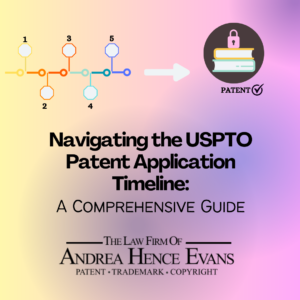Navigating the USPTO Patent Application Timeline: A Comprehensive Guide
Securing a patent for your invention is a significant milestone in the journey of innovation, offering legal protection and exclusive rights to your groundbreaking idea. However, the process of obtaining a patent can be complex and time-consuming, requiring careful navigation of the United States Patent and Trademark Office (USPTO) patent application timeline. In this guide, we’ll walk you through the various stages of the patent application process and provide insights into what to expect at each step.
- Preparing Your Patent Application:
Before submitting a patent application to the USPTO, it’s essential to conduct thorough research to ensure that your invention is novel, non-obvious, and adequately described. This involves conducting a comprehensive patent search to identify prior art and drafting a detailed patent application that accurately describes your invention’s features, functionality, and potential applications.
- Filing Your Patent Application:
Once your patent application is prepared, you can file it with the USPTO either electronically or by mail. Upon submission, you’ll need to pay the requisite filing fees and provide any necessary supporting documentation, including drawings, specifications, and claims outlining the scope of your invention’s protection.
- Patent Examination Process:
After filing your patent application, it undergoes a thorough examination process conducted by a patent examiner at the USPTO. The examiner reviews your application to determine its compliance with patent laws and regulations, including novelty, non-obviousness, and utility. During this stage, the examiner may issue office actions requesting additional information, amendments, or clarifications regarding your invention.
- Office Actions and Responses:
Throughout the examination process, you may receive one or more office actions from the patent examiner outlining objections, rejections, or deficiencies in your application. It’s essential to carefully review each office action and respond promptly with thorough arguments, amendments, or evidence to address the examiner’s concerns and overcome any objections raised.
- Patent Prosecution:
The process of responding to office actions and negotiating with the patent examiner to secure patent approval is known as patent prosecution. This stage may involve multiple rounds of correspondence and revisions to your application until all issues are resolved, and the examiner determines that your invention meets the requirements for patentability.
- Patent Grant or Final Rejection:
Upon successful completion of the examination and prosecution process, the patent examiner will issue either a Notice of Allowance, indicating that your patent application is approved for issuance as a granted patent, or a Final Office Action, indicating that your application has been finally rejected. If your application is allowed, you’ll need to pay the issue fee to receive your granted patent.
- Patent Maintenance and Enforcement:
Once your patent is granted, you’ll need to pay maintenance fees periodically to keep it in force. Additionally, you’ll have the exclusive right to enforce your patent against infringers, including initiating legal proceedings to prevent unauthorized use, sale, or distribution of your patented invention.
Navigating the USPTO patent application timeline requires patience, persistence, and attention to detail. By understanding the various stages of the patent application process and diligently adhering to USPTO requirements, inventors can successfully secure patent protection for their innovative ideas and bring their inventions to market with confidence.

